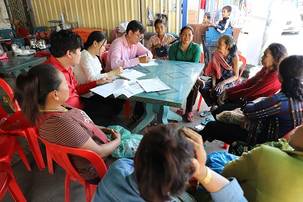
Since 2004, highly pathogenic avian influenza (HPAI) outbreaks have been widely reported in Cambodia. Takeo Live Bird Market (LBM) is one of the largest of its kind in the country, connecting the poultry value chain countrywide. To combat the transboundary animal disease (TAD) threat in the region, the General Directorate of Animal Health and Production (GDAHP), Ministry of Agriculture, Forestry and Fisheries of Cambodia, and the Food and Agriculture Organization of the United Nations (FAO) Emergency Centre for Transboundary Animal Diseases (ECTAD) collaborate to upgrade the biosecurity and biosafety of the Takeo LBM and its poultry value chain under the project “Evidence Based Risk Management Along the Livestock Production and Market Chain”. This project is supported by the United States Agency for International Development and the Australian Government.
Studies by the Institut Pasteur du Cambodge (IPC) and the National Animal Health and Production Research Institute (NAHPRI) have highlighted the importance to improve the hygiene of the LBM. Substantia circulation of influenza virus of different subtypes in the LBM, detected in the live poultry being sold, is putting stakeholders at risk.
Women participation in the Takeo LBM design
Multilevel efforts are needed to establish a safe model LBM. In order to empower the female stakeholders, the project is supporting the formation of a women sub-committee, consisting of five poultry vendors and five slaughter operators. This sub-committee, expected to be officially endorsed in 2019, will be trained by the project on improved LBM biosafety and biosecurity and will work in collaboration with the Takeo LBM Management Committee, providing feedback on the LBM design and operation.
After being engaged with the project, Ms Sok Chea, one of the vendors, has realized the significance of safer LBM facilities and practices for her poultry selling business in order to generate a daily income to support her family.
She stated that, “the reconstructed LBM will provide many benefits since the current slaughtering area isn’t clean, and we need to sell poultry along the street. In the model LBM, the slaughtering area will be separated from live poultry selling, and both areas will be cleaner. We hope this will result in more future customers.”
According to Mr. Dith Sideth, “involvement of women in the decision making process is key to successfully achieve the project goal.” He added that “a recent gender assessment done under the project found obstacles for women to express their opinions and limited opportunities for them to participate in the trainings or meetings”. “By involving women vendors, slaughter operators and collectors in the decision making processes, the project will more likely to succeed in establishing a sustainable and safer LBM with maintained livelihoods,” he emphasized.
Sok Chea, the poultry vendor and expected chief of the women sub-committee said that, “The establishment of a women sub-committee is useful. It will serve as a formal platform for us to discuss and seek consensus on any particular thoughts or suggestions. After that, we can bring issues and share our ideas with the market authority.”
The women sub-committee has so far been engaged with the project through Focus Group Discussions (FGDs) involving elaborations and decisions on the LBM design. They are happy with the agreed final design that responds well to their needs, and hope the new LBM will allow them to do better business.
Legal framework for LBM operation and biosecurity procedures in poultry production
Besides working closely with the women sub-committee and the market authority, the project strives for improved LBM governance and environmental sustainability through close interaction with the General Directorate of Animal Health and Production (GDAHP), the EU Programme “Promotion of Inclusive and Sustainable Growth in the Agricultural Sector: Fisheries and Livestock”, and relevant national and sub-national stakeholders for amending some articles of Sub-Decree 108 and Prakas No. 16 under the Animal Health and Production Law. The approved amendments will further ensure mitigating of the risk of Avian Influenza virus and proper functioning of the restructured Takeo LBM.
During a consultation in late 2018, involving also the private sector, two crucial points related to poultry selling and slaughter regulation were proposed and agreed upon:
It was proposed and agreed to add another clause with special conditions for poultry slaughtered in LBMs under Article 8, Point B of the Sub Decree, stating, “Poultry shall be contained for at least two hours”. This point is important to allow sufficient time for poultry inspection before slaughter.
2. Prakas No. 16:
“Forced feeding of poultry shall be banned” was proposed as additional text of Article 9, Point A of the Prakas. The ban on forced feeding is an important step towards reducing the risks of disease transmission, and protect poultry welfare.
